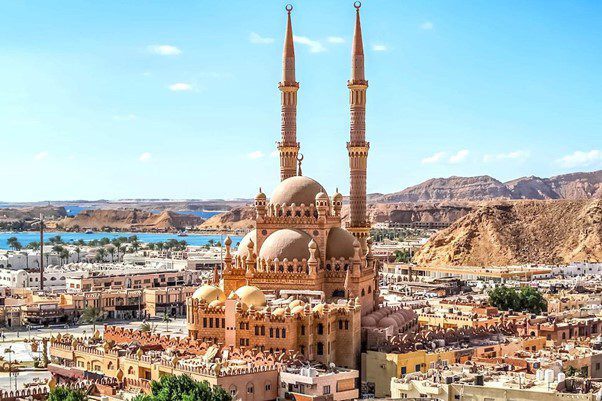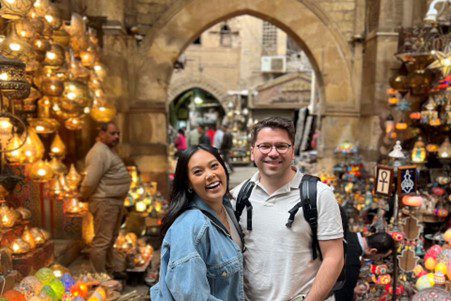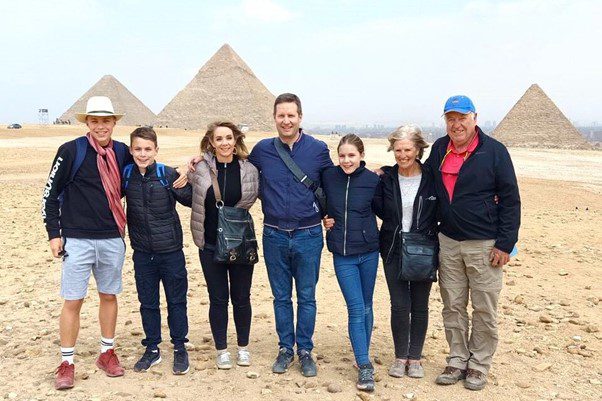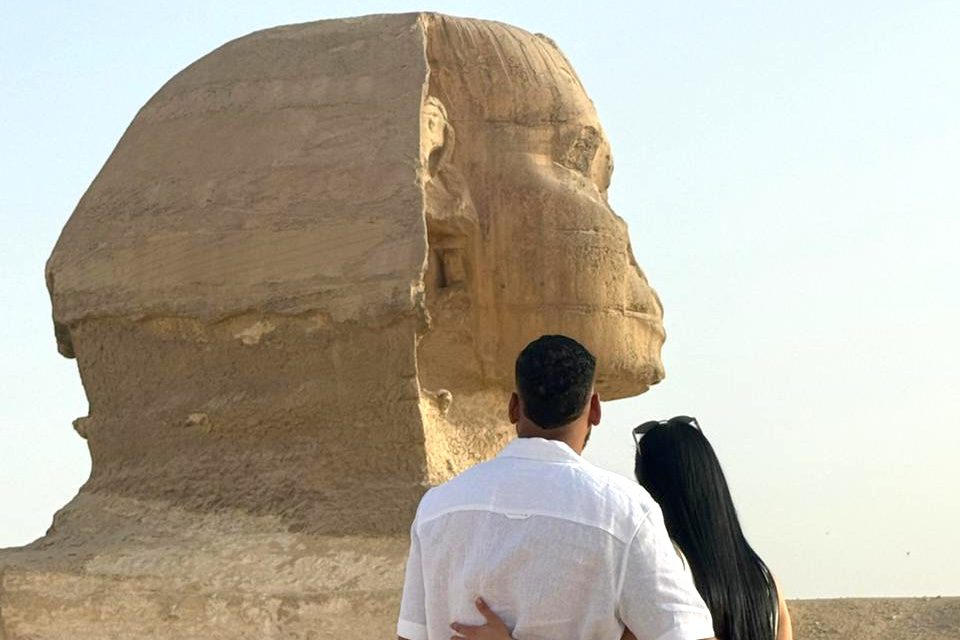
Thinking of escaping Cairo for the day? Alexandria is a top-notch choice—and taking the train makes it even better. It’s budget-friendly, surprisingly relaxing, and gives you a scenic ride through Egypt’s countryside before you even reach the coast. Let’s break it all down—real talk, timetables, costs, and a few street-smart tips to help you make the most of your Alexandria adventure. Why Take the Train to Alexandria? Sure, you could drive—but Cairo traffic is no joke. The train ride is part of the experience: in about three hours, you’ll glide past lush green fields, small villages, and the beautiful Nile Delta. No car horns, no GPS stress. Just you, some snacks, your playlist, and peaceful views out the window. And once you’re in Alexandria? Sea breeze, ancient sites, and Mediterranean charm await. Train Schedules: What’s the Best Option? Trains from Cairo to Alexandria run throughout the day—starting early morning and continuing until late at night. Here’s what to look for: • Spanish (Special Class) Trains: Fast, comfortable, air-conditioned, and a bit more polished. Tourists love these for a reason. • Regular First-Class Trains: Still decent, and a great budget option. Maybe not luxury, but definitely doable for a day trip. Suggested departure: Around 7:00 AM if you want a full day in Alexandria. Return trip: Between 5:00 PM and 7:00 PM works well for most travelers. Ticket Prices: Surprisingly Affordable • Spanish Train (Special Class): 100–150 EGP (~$3–5 USD) • Regular First Class: 80–100 EGP (~$2.50–3.50 USD) You can buy tickets at the station, but lines can be long and chaotic—especially in the morning. If you prefer a smoother experience, ask a local travel agent or tour service like PyramidsTrip to book your tickets and transfers. What to See in Alexandria in One Day You can cover a lot in a single day if you plan right. Don’t miss: • Citadel of Qaitbay – Built on the site of the ancient Lighthouse of Alexandria. Instagram-worthy and full of history. • Bibliotheca Alexandrina – A stunning modern library and cultural hub. Worth it even if you’re not a bookworm. • Montaza Palace Gardens – Gorgeous royal gardens with a sea view. Great for a walk or picnic. • Stanley Bridge & the Corniche – Perfect for a sunset stroll or that dreamy selfie with the sea in the background. Tip: Alexandria is full of cafés. If you get lost in one for an hour or two? Totally valid. Quick Tips from Locals • It’s breezy: Even in summer, Alexandria can feel cool—especially near the sea. A light jacket can come in handy. • Fridays = slow starts: Friday is Egypt’s weekend, so some museums or attractions may open late or close early. • Hate logistics? Let a local tour company like PyramidsTrip handle your transport, tickets, and timing. Saves a lot of hassle, especially for first-timers. Final Thoughts An Alexandria day trip by train is one of Egypt’s best-kept travel secrets. You get a mix of history, coastlines, and calm—all without spending much. Whether you’re snapping photos by the sea or sipping mint tea with a view, it’s a day well spent. Just don’t forget sunscreen, a good playlist, and some room in your camera roll. Trust us—you’ll need it.

Ramadan is a sacred and spiritual month for Muslims around the world. If you’re planning a trip to Egypt during this time, it’s important to understand how Ramadan can shape your travel experience. While Egypt remains a welcoming destination, travelers might notice subtle but meaningful changes in the daily rhythm, especially in Egypt tours packages designed around this holy season. What to Expect During Ramadan in Egypt During Ramadan, most locals fast from sunrise to sunset. This means that many restaurants and cafes remain closed during the day, with most activity picking up after the evening call to prayer. Tour packages adjust to these cultural rhythms, offering travelers a chance to experience Egypt in a more authentic and peaceful way. If you’re exploring historical sites like the Pyramids of Giza or the Egyptian Museum, you’ll find these attractions open but with adjusted hours. Many tour operators plan early morning visits or late afternoon tours to accommodate both local customs and traveler comfort. How Egypt Holiday Packages Adapt Tourism doesn’t stop during Ramadan—in fact, it can be a special time to visit. Many Egypt holiday packages include cultural activities like attending an Iftar (evening meal) with local families or watching traditional music performances that come alive after dark. Hotels and resorts continue to offer full services, and private guides often provide extra flexibility to ensure travelers enjoy their journey without discomfort. Transport services, Nile cruises, and day trips operate normally but might shift schedules slightly. Unique Ramadan Experiences for Tourists One of the most enriching aspects of visiting Egypt during Ramadan is experiencing the festive nights. The streets are beautifully lit, with lanterns (fanoos) hanging from balconies, and bazaars bustling with life after sunset. Your Egypt tours package might include special evening excursions to enjoy the local food markets and street performances in places like Cairo’s Khan El Khalili bazaar. A Time for Cultural Connection Rather than being a limitation, traveling during Ramadan offers a chance for deeper cultural understanding. Tourists are often welcomed warmly and are encouraged to participate in local traditions respectfully. It’s a time when hospitality is heightened, and locals are eager to share their culture and values with visitors. Whether you’re a solo traveler or coming with family, choosing the right Egypt tour package during Ramadan ensures you experience the country in a unique and meaningful way. Just be prepared for a slightly slower pace—and some unforgettable evenings under the stars.

If you really want to experience Cairo beyond the pyramids (don’t worry, you can go back later), head downtown. This part of the city is chaotic in the best way: honking cars, the smell of grilled kebabs in the air, and buildings so full of character they practically talk back. It’s gritty, loud, and full of life—and most importantly, it’s where Cairo’s real food scene lives. Forget overpriced tourist restaurants with English menus. The real flavors are tucked away in fogged-up windows, behind crowds of hungry locals, or on street corners that don’t show up on TripAdvisor. Why Downtown Cairo is a Foodie’s Paradise Downtown Cairo is the heartbeat of the city. Sure, the historic buildings and vintage architecture are beautiful—but the real magic is in the food. Most places don’t even have signs, just regulars who’ve been coming for years. If you’re unsure where to start, follow your nose—or the longest line of locals. And if you’re new to the area or your Arabic isn’t quite there yet, consider booking a local guide (like the ones from Pyramids Trip). They’ll lead you to hidden gems and keep you from falling into tourist traps. Local Cafés Worth Finding Café Riche – A Slice of Cairo History Located on Talaat Harb Street, Café Riche is an institution. Step inside and you’ll feel like you’ve time-traveled. The creaky floors, vintage decor, and walls heavy with history are just the beginning. This place has hosted everyone from revolutionaries to poets. Grab a strong cup of Egyptian coffee and soak in the nostalgia. Eish + Malh – Old Meets New Tucked away on Hoda Shaarawi Street, Eish + Malh blends Cairo’s soul with a modern twist. It’s the kind of place where creatives hang out, laptops open, coffee flowing. Their menu mixes Egyptian classics with global flavors—think shakshouka for breakfast, and Neapolitan-style pizza for dinner. Great for chilling, people-watching, or catching up on journaling your Cairo adventures. Street Food Spots That Locals Swear By Felfela – Legendary Egyptian Falafel Cairo has no shortage of taameya spots (Egyptian falafel), but Felfela is a favorite. Crispy on the outside, green and herby inside, served in fresh baladi bread with tahini—it’s the kind of simple, cheap street food that stays with you. Skip the hotel breakfast and come hungry. El Abd Patisserie – Dessert Heaven If you’ve got a sweet tooth, El Abd on Talaat Harb is your dream come true. Known for classic Egyptian desserts, you’ll find everything from syrup-soaked basbousa to rich rice pudding and flaky konafa. Buy a box, pretend you’ll share, and then devour it on your walk back. We won’t judge. Tips to Find the Real Spots It’s easy to miss the best spots if you don’t know where to look. Downtown is a maze, and many of these place’s blend into the scenery. The safest bet? Hire a local guide. Tour operators like Pyramids Trip can take you off the beaten path, introduce you to authentic eats, and tell the backstories that make the food taste even better. Final Word Downtown Cairo is messy, noisy, and utterly delicious. It’s where you’ll find cafés older than most cities, street food that could ruin fast food for you forever, and an energy that’s pure Egypt. Take a break from the postcard landmarks and eat where the locals do. Trust us—it’s these moments you’ll remember long after your trip ends.

Planning a family trip can be a challenge, especially when traveling with young children. But Egypt—rich in history, culture, and adventure—can be a surprisingly kid-friendly destination if you choose the right travel plan. From camel rides near the pyramids to boat cruises along the Nile, there are many ways to explore this fascinating country while keeping the entire family happy and engaged. Why Egypt Is Great for Families Egypt is more than just ancient ruins. It offers exciting, interactive experiences that are perfect for curious young minds. Children love exploring the Pyramids of Giza, sailing on traditional feluccas, and learning about the fascinating world of pharaohs and mummies. In cities like Luxor and Aswan, many temples and museums now offer guided tours designed specifically for kids, making learning fun and stress-free for parents. What to Look for in a Family-Friendly Package When traveling with children, comfort and convenience matter most. A good Egypt tours package should include things like airport pickup, kid-friendly meals, safe transport, and accommodations with family rooms or suites. Having an English-speaking guide who can explain things in an engaging way is also a big plus. Look for itineraries that balance sightseeing with downtime—too many early starts and long tours can wear out both kids and parents. Packages that include hands-on experiences, like pottery workshops or local cooking classes, can also add fun to the trip. Top Ideas for Stress-Free Family Itineraries 1. Cairo and Giza with a Day Cruise A 3- to 4-day package that covers the Egyptian Museum, a visit to the pyramids, and a gentle cruise on the Nile can be the perfect introduction for younger travelers. 2. Nile Cruise with Luxor and Aswan Families with older kids might enjoy a longer Egypt holiday package that includes a few days aboard a cruise ship, visiting famous temples like Karnak and Philae while relaxing in between stops. 3. Red Sea Resort Combo After some history and adventure, unwind at a beach resort in Hurghada or Sharm El-Sheikh. Many family packages now combine cultural sightseeing with a few days by the sea, giving kids time to swim and play. To explore more Egypt holiday packages designed for families, check out the options available here: Final Tips for Parents Make sure to pack sunscreen, hats, and plenty of water bottles—Egypt’s sun can be strong. Also, prepare kids with a simple storybook or video about ancient Egypt before the trip to spark their interest. Finally, booking a well-planned family package with trusted operators helps reduce travel stress and lets you focus on making memories.
Planning Your Dream Trip with the Best Egypt Tour Company When it comes to planning your trip to Egypt, timing can make a world of difference. From exploring the majestic Pyramids of Giza to cruising the Nile or discovering ancient temples in Luxor and Aswan, each season offers a unique experience. In this guide, we break down the best time to visit Egypt month by month—helping you choose the right time based on weather, crowds, and travel deals. Whether you’re a history enthusiast, sun-seeker, or budget traveler, working with the best Egypt tour company ensures a seamless and unforgettable experience. Let’s dive into what each month has to offer. January – Cool Weather, Fewer Tourists January is one of the coolest months in Egypt, with temperatures averaging 9–19°C (48–66°F). It’s an ideal time for sightseeing, especially around Cairo and the historical sites in Upper Egypt. Crowds are moderate after the New Year peak, and prices drop slightly. Best for: Cultural tours, desert exploration, and Nile cruises. Tip: Book early with the best travel agent in Egypt for special winter deals. February – Pleasant Climate, Great for Sightseeing Similar to January, February offers mild weather and fewer crowds. It’s a perfect time to explore the Valley of the Kings or take a hot air balloon ride over Luxor. Best for: History lovers and couples on romantic getaways. Deals: Mid-season discounts available through experienced Egypt tour operators. March – Beginning of Spring Temperatures begin to rise but remain comfortable. Wildflowers bloom in some desert areas, and tourist numbers start to grow, especially during Easter holidays. Best for: Balanced weather, scenic beauty, and cultural events. Note: Book early with a reputable tour company to avoid holiday price hikes. April – Warm Days, Bustling Sites April brings warmth and brighter days. It’s one of the best months for Nile cruises and Red Sea visits. Tourist spots are bustling, but not overly crowded. Best for: Photography, beach trips, and luxury cruises. Travel Tip: Coordinate your itinerary with the best tour operator in Egypt for smooth transitions. May – Hotter Days Begin May is the shoulder season—hot during the day but still manageable. This is when you start seeing better deals on flights and accommodations. Best for: Budget travelers and those comfortable with heat. Tip: Start early in the mornings for temple visits and explore shaded markets midday. June to August – Peak Heat, Lowest Prices These summer months are Egypt’s hottest, with temperatures soaring above 40°C (104°F). Tourism dips significantly, making this a great time for budget travelers and those seeking solitude. Best for: Red Sea resorts (like Hurghada and Sharm El Sheikh) and indoor museums. Deals: Excellent offers available when booking with the best travel agent in Egypt. September – Heat Eases, Tourism Rises Temperatures begin to drop slightly, and tourism picks up again. It’s a great time to visit temples and markets before the high season hits. Best for: Affordable travel with fewer crowds. Tip: Partner with an experienced tour operator to plan a balanced itinerary. October – Ideal Weather Returns October is considered one of the best months to visit Egypt. The heat is manageable, the skies are clear, and major tourist attractions are buzzing with energy. Best for: First-time visitors, family vacations, and cultural events. Travel Advice: Secure your trip with the best Egypt tour company for premium experiences. November – Peak Season Begins As the weather cools further, Egypt enters its peak season. Expect more crowds and higher prices, especially around major holidays. Best for: Festivals, historical exploration, and Nile cruises. Booking Tip: Lock in your package early to ensure availability and good rates. December – Festive and Fantastic With Christmas and New Year celebrations, December is festive and vibrant in Egypt. The weather is excellent for sightseeing, and coastal cities light up with events. Best for: Holidaymakers and winter travelers. Note: Work with the best tour operator in Egypt to plan festive itineraries with local flavor. Final Thoughts: When Should You Go? There’s truly no bad time to visit Egypt—it all depends on your travel goals. For comfortable weather and rich experiences, October to April is ideal. If you’re looking for deals and don’t mind the heat, summer can be surprisingly rewarding. To make the most of your Egypt adventure, team up with the best Egypt tour company. A professional, local tour operator can help you navigate the seasons, get the best deals, and discover hidden gems that most tourists miss.

Planning a trip to Egypt in 2025? Whether you’re dreaming of exploring the Great Pyramids, cruising the Nile, or diving into the colorful culture and cuisine, the first question most travelers ask is: How much does an Egypt holiday package cost in 2025? The short answer? It depends on what kind of experience you’re looking for. Budget, Mid-Range, or Luxury? Egypt offers a wide range of travel packages to suit different budgets. In 2025, Egypt holiday packages generally fall into three main categories: • Budget Packages: Starting from around $500 to $800 per person for a 5–7-day trip. These typically include 3-star accommodations, basic sightseeing tours, and transport between cities like Cairo, Luxor, and Aswan. • Mid-Range Packages: Ranging from $900 to $1,500, these often include 4-star hotels, guided tours with entry tickets to major attractions, and possibly a short Nile cruise. • Luxury Packages: For a more indulgent experience, prices can start from $2,000 and go upwards, offering 5-star stays, private guided tours, gourmet meals, and upgraded transportation. You can browse various Egypt holiday packages to see options that match your travel style and preferences. What Affects the Price? Several factors influence how much you’ll pay for an Egypt tour: • Season: Traveling in peak season (October to April) often costs more due to high demand. • Duration: The longer the trip, the more it will cost, though some longer tours offer better per-day value. • Inclusions: Packages with domestic flights, all-inclusive meals, and private guides naturally cost more than basic sightseeing tours. • Group Size: Private or couple-based packages tend to be pricier than group tours, but offer more personalized experiences. If you’re planning a family vacation, honeymoon, or solo adventure, there’s always a suitable Egypt tours package to choose from. Final Thoughts The cost of an Egypt holiday package in 2025 can be as affordable or as luxurious as you make it. From backpackers to honeymooners, Egypt remains one of the most value-packed destinations for discovering ancient wonders and modern hospitality. Do your research, compare packages, and book early to lock in the best rates. So, ready to explore the land of pharaohs? Your dream Egyptian journey is just a package away.

Planning a trip to Egypt in 2025? Whether you’re a budget backpacker or a luxury traveler, Egypt offers a range of travel styles to suit every budget. In this guide, we’ll break down real travel costs—from hostels and street food to five-star resorts and private tours—so you can plan your dream trip wisely and avoid hidden surprises. Why Egypt is a Top Destination in 2025 Egypt continues to be one of the most affordable and culturally rich travel destinations in 2025. With ancient wonders like the Pyramids of Giza, the Nile River, and the Valley of the Kings, it offers unforgettable experiences at a fraction of what you’d pay in other bucket-list destinations. To make the most of your Egypt adventure, it’s highly recommended to book through the best Egypt tour company that can provide expert guidance, reliable services, and custom travel plans. 1. Budget Traveler (Backpacker) – Approx. $30–$50 per day Backpacking through Egypt is a rewarding and affordable experience. Here’s a rough cost breakdown for budget travelers: • Accommodation: $8–$15/night for hostels or budget guesthouses in cities like Cairo, Luxor, and Aswan • Food: $5–$10/day with local eats like falafel, koshari, and shawarma • Transportation: $1–$2 for metro rides in Cairo, $5–$15 for longer train or bus trips • Attractions: Many entry tickets range from $1–$10; student discounts available • Daily Total: $30–$50 Tips: • Travel overnight by train to save on accommodation • Use apps like Uber or Careem to avoid taxi overcharging • Join group day trips through a trusted travel agent in Egypt to explore more affordably 2. Mid-Range Traveler – Approx. $70–$150 per day If you prefer more comfort, air-conditioned hotels, and guided tours, the mid-range budget works well. • Accommodation: $30–$70/night for 3-star hotels or boutique stays • Food: $10–$25/day at a mix of local and international restaurants • Transportation: Domestic flights start at $30 (Cairo to Luxor/Aswan), or opt for comfortable trains • Tours & Attractions: Group tours cost around $40–$100 per day, often including transport and guide • Daily Total: $70–$150 You’ll get a more curated experience if you choose packages from the best tour operator in Egypt, who can help you explore major attractions like Abu Simbel, the Egyptian Museum, and Nile River cruises without the stress of planning everything yourself. 3. Luxury Traveler – Approx. $200–$600+ per day For those seeking a high-end Egyptian experience with exclusive perks, Egypt delivers luxury at great value. • Accommodation: $150–$300+/night at 5-star hotels such as Marriott Mena House or Sofitel Legend Old Cataract • Food: $50–$100/day with fine dining, rooftop views, and Nile-side restaurants • Transportation: Private airport transfers and domestic flights, or luxury sleeper trains • Private Tours: Custom itineraries with expert Egyptologists, private cars, and VIP access ($150–$400/day) • Luxury Nile Cruises: Start from $500+ for a 3-night cruise with all meals and excursions included • Daily Total: $200–$600+ Booking with the best travel agent in Egypt ensures smooth coordination, 24/7 support, and access to premium experiences tailored to your interests. Bonus: What’s Usually Included in Tour Packages? Whether your budget-conscious or booking luxury, tour packages in Egypt often include: • Airport transfers • Hotel accommodations • Entrance tickets to major attractions • Transportation between cities • Guided tours with professional guides • Meals (in some cases) Pyramids Trip, one of the best Egypt tour companies, offers fully customizable packages that match your budget and preferences, making it easy to get more value for your money. Final Thoughts: Is Egypt Expensive in 2025? Egypt is still one of the most affordable travel destinations in the world. From shoestring adventures to five-star getaways, the cost of travel in Egypt in 2025 depends entirely on how you want to experience it. To ensure you’re getting the best experience for your budget, work with the best tour operator in Egypt who understands local pricing, knows the top destinations, and can offer insider perks.

Traveling to Egypt soon? Whether it’s your first time or a long-anticipated return, landing in a new country can be overwhelming. From the moment your plane touches down, there’s a checklist of essentials to tackle. That’s where working with a local expert makes all the difference. Here’s your complete arrival checklist curated by local agents to help you feel confident, connected, and in control. 1. Handle Your Visa the Easy Way Egypt requires visas for many travelers, but the process doesn’t have to be stressful. While you can apply online or upon arrival, the easiest and most hassle-free method is arranging it in advance with a trusted local travel agent. Why Use a Local Agent for Visas? Local travel agents in Egypt are well-versed in the latest entry regulations and can help you avoid last-minute issues. They’ll take care of the paperwork, alert you to any changes, and ensure you arrive with peace of mind. Partnering with the top travel agent in Egypt ensures you won’t waste time in long queues or get held up by incomplete forms. 2. Get a Local SIM Card for Instant Connectivity As soon as you land, staying connected becomes a priority—especially if you’re coordinating airport pickups, hotel check-ins, or day-one activities. Where to Get a SIM Card in Egypt You can buy SIM cards at the airport, but prices there are often inflated. A smarter move? Let your local agent pre-arrange one for you, so you’re online the moment you arrive. With data and calling plans tailored for tourists, you won’t have to worry about getting lost or missing important bookings. Plus, they’ll even help activate it and make sure everything works before you leave the airport. 3. Pre-Book Your Airport Transfer There’s nothing worse than arriving in a new country, tired from your flight, only to haggle with taxi drivers or deal with rideshare apps that won’t load. Stress-Free Airport Transfers Pre-arranged transfers take the guesswork out of arrival. A professional driver will greet you at the airport with your name on a sign—no confusion, no scams, and no language barriers. Many travelers who book through Pyramids Trip find this service to be one of their most valuable experiences, especially when arriving late at night or with family in tow. Final Tip: Local Help Makes a World of Difference From visa help and SIM setup to stress-free transfers, having the support of a trusted travel agent makes your arrival smooth and memorable. Instead of scrambling to sort things out on your own, everything’s done for you—by professionals who know Egypt inside and out. If you’re planning a visit soon, working with the top travel agent in Egypt ensures your trip starts on the right foot.

Planning your dream trip to Egypt but unsure about safety? Get honest insights, updates, and tips from a trusted local expert. Egypt has long been a land of wonder, attracting millions of visitors with its majestic pyramids, ancient temples, and vibrant local culture. But for many travelers, one important question remains: Is Egypt safe to visit in 2025? As a trusted local tour operator in Egypt, we understand your concerns. This article offers practical advice, safety updates, and tips you can count on — straight from one of the best Egypt tour companies, Pyramids Trip. What’s the Current Safety Situation in Egypt? As of 2025, Egypt is safe and welcoming for tourists, especially in popular destinations like: • Cairo and Giza (home of the Great Pyramids) • Luxor and Aswan (famous for Nile cruises and temples) • Sharm El Sheikh and Hurghada (Red Sea resorts) • Alexandria and Siwa Oasis The Egyptian government continues to invest heavily in tourism security, with visible police presence, regular safety checks, and tourist police assigned to key sites. Roads to major tourist destinations are well-patrolled and monitored. Travelers on guided tours or organized packages generally experience a smooth and safe journey, especially when booking through the best tour operator in Egypt who knows how to navigate both urban and rural areas safely. Areas to Avoid in Egypt (2025) Although Egypt is largely safe, like any country, there are areas that travelers are advised to avoid. These include: • The North Sinai region, which has ongoing military activity. • Border areas with Libya and Sudan. • Isolated desert routes not included in guided tours. Most of these areas are far from typical tourist routes and are not included in any major travel itinerary. Travel Tips from a Local Tour Operator in Egypt Here are a few essential travel safety tips to help you enjoy your trip with peace of mind: 1. Book with a Reputable Tour Company Avoid independent or unregistered travel agents. Choose a licensed and trusted travel agent in Egypt who offers transparent service and reliable local knowledge. 2. Join Group Tours or Private Guided Trips These options are not only safer but also help you explore deeper with cultural insights and language support. 3. Respect Local Customs and Dress Modestly Egypt is a conservative country. Wearing respectful clothing, especially in rural or religious areas, helps you blend in and stay comfortable. 4. Stay Aware in Crowded Areas Keep personal belongings secure when visiting markets or tourist hotspots. Petty theft is rare but can happen in crowded spaces. 5. Use Hotel Safes for Valuables Most 3-star and above hotels in Egypt provide in-room safes. Use them for passports, cash, and electronics. 6. Register with Your Embassy If your home country offers embassy registration for travelers, it’s a good idea to enroll your trip details in case of emergencies. Why Travel with Pyramids Trip? At Pyramids Trip, we pride ourselves on being one of the best Egypt tour companies for a reason. Our tours are designed by locals, for travelers — ensuring both authenticity and safety. Whether you’re cruising the Nile or exploring the wonders of ancient Cairo, we handle everything — so you can relax and enjoy. • 100% licensed and experienced guides • Real-time local support • Custom travel planning with top safety standards • Competitive rates with no hidden fees With our team of expert travel agents in Egypt, you’ll be in safe hands from airport pick-up to drop-off. Final Thoughts: Is Egypt Safe to Visit in 2025? Absolutely — especially when you’re traveling smart and choosing the right travel partner. Egypt in 2025 is not only safe for tourists, but more prepared than ever to welcome travelers with world-class hospitality, upgraded infrastructure, and warm local vibes. By working with the best tour operator in Egypt, you’ll ensure a stress-free, enriching journey through one of the most magical places on earth. Ready to Explore Egypt? 📞 Contact us at +2 0155 100 14 33 or 📧 info@pyramidstrip.com Or browse our Egypt Tour Packages and Nile Cruises to get started.









